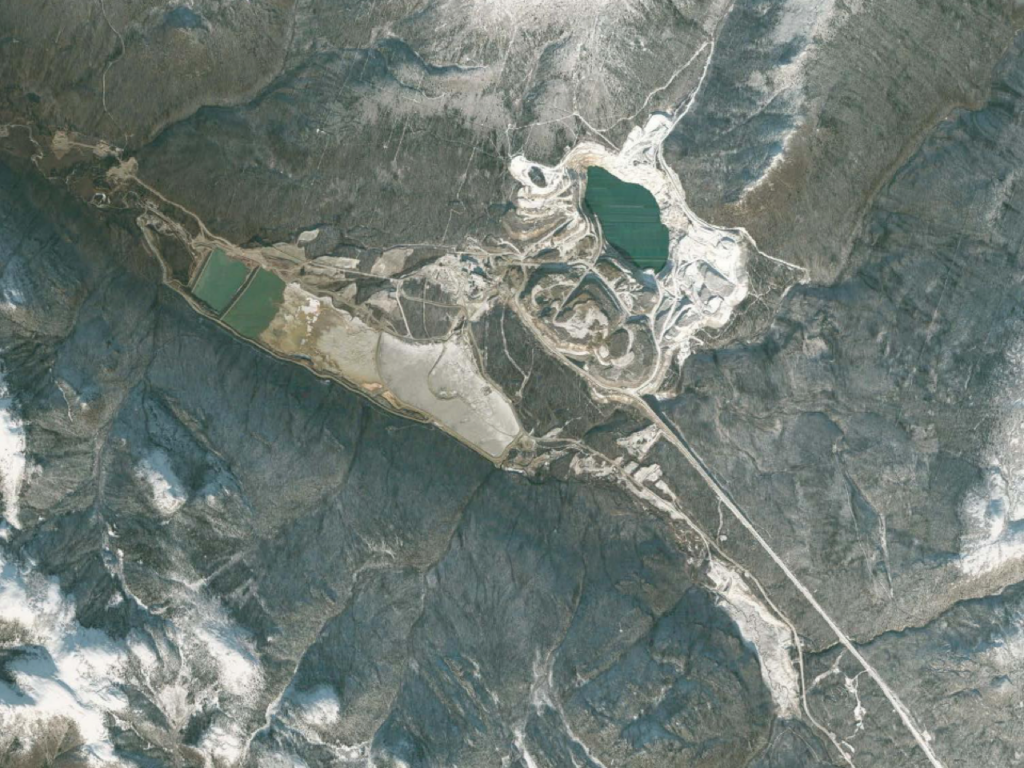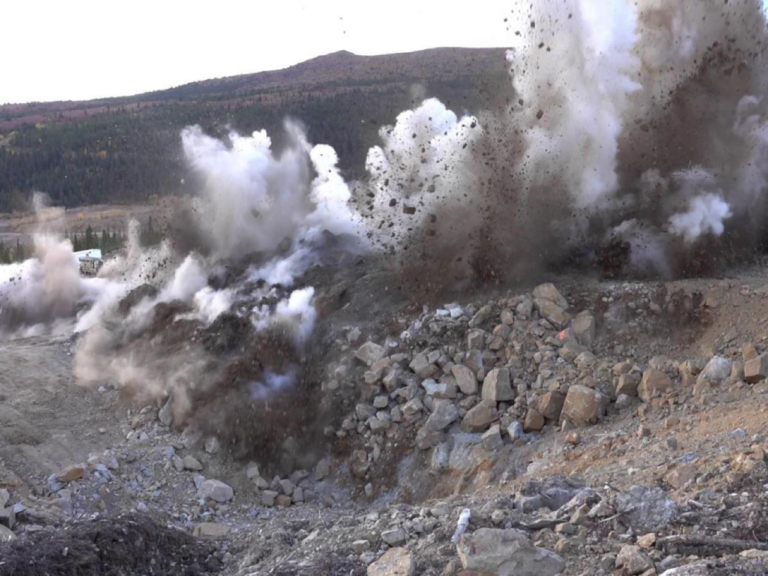About the Faro Mine
Faro Mine was once the largest open pit lead-zinc mine in the world
Today, it is the site of one of the most complex abandoned mine remediation projects in Canada. The mine spans 25 sq. km, an area roughly the size of the city of Victoria, British Columbia.
It is located in south-central Yukon, near the town of Faro, on the traditional territory of the Kaska Nations, and upstream from Selkirk First Nation. The mine was abandoned in 1998.
Processing minerals at the mine left behind 70 million tonnes of tailings and 320 million tonnes of waste rock. This waste has the potential to leach metals and acid into the surrounding land and water.
Mining left behind 70 million tonnes of tailings and 320 million tonnes of waste rock. These wastes can release metals and acid onto the land and into water.
The Project
The Faro Mine Remediation Project is a plan to clean up the abandoned mine
The Faro Mine Remediation Project (the Project) is a plan to clean-up the abandoned mine. There will be two phases in the remediation plan: a construction phase, when the Faro Mine Site is being remediated and a long-term operations and monitoring phase when the water treatment plant is being operated and the site is being monitored.
An approach called stabilize in place will be used for the remediation of the Faro Mine Site. This means keeping the tailings and wastes in the same location and ensuring that they are stable to protect people and the environment.
There will be two phases, in the remediation plan:
Phase 1.
The first phase is called active remediation. This is when most of the work needed to clean-up the site, like construction activities, will be done. Active remediation will take about 15 years.
Phase 2.
The second phase is called long-term operations and maintenance. This phase will begin once construction and clean-up are finished and will include monitoring and upkeep activities as well as water treatment that will continue into the very far future.
The site will remain under care and maintenance until remediation activities can begin.
Objectives for Remediation
There are five overall objectives for the remediation of the Faro Mine Site:
- 1
Protecting human health and safety
- 2
Protecting and, to the extent practicable, restoring the environment including land, air, water, fish, and wildlife
- 3
Returning the mine site to an acceptable state of use that reflects pre-mining land use where practicable
- 4
Maximizing local and Yukon socio-economic benefits
- 5
Managing long-term site risk in a cost-effective manner

History of the Faro Mine
Information outlining the brief history of Faro Mine and path forward through remediation
In 1953, prospectors staked a claim that would eventually become the Faro Mine. Exploration in the area led to the discovery of the Faro mineral deposit in 1965 and the Grum deposit in 1973. Cyprus Anvil Mining officially opened the Faro Mine in 1969, and it quickly became one of the largest employers in the territory. The Faro Mine would eventually become the largest zinc-lead mine in Canada, forming more than 30% of the economy of Yukon.
Cyprus Anvil Mining was forced to shut down operations in 1984 and the mine changed hands a few times in the years that followed. Mining continued into the mid-1990s, but because of world metal prices, the new owner Curragh Resources, went bankrupt. Anvil Range Mining re-opened the mine in 1995 and ran it until 1997. The mine closed permanently after nearly 30 years of mining when it was abandoned in 1998.
The Faro Mine Site is located within the traditional lands of the Kaska Nations, and upstream of the Selkirk First Nation. Indigenous people used the land of the Faro Mine Site and surrounding area well before the mine existed and will continue to use the land long after remediation has taken place.
Continuing Care and Maintenance
Outline the type of work within the project, broad aproach

The Faro Mine Site is currently in care and maintenance, which includes monitoring water quality, collecting and treating contaminated water, checking that water leaving the site meets water quality standards and maintaining site infrastructure, like roads, buildings, dams, and water diversions. An important goal will be to prevent clean water from flowing into areas where it could become contaminated and unsafe. Treating contaminated water and monitoring the water will continue to be a priority in the future.
Water Treat Operators Needed! – As part of on-going care and maintenance, a water treatment plant located at the Cross Valley Pond will be used to treat water from the Cross Valley tailings pond so that it can be safely released to the environment.
Activities that are planned to help keep clean water clean include:
01
Moving the Faro Creek Diversion to keep clean water away from the Faro Pit.
02
Completing the work needed to finish the North Fork Rose Creek Diversion.
03
The last portion of North Fork Rose Creek will be diverted so that it avoids an area where groundwater is seeping out of a waste rock dump into the creek. The creek channel will be moved to protect North Fork Rose Creek from this groundwater.
04
Building a new water diversion called the Down Valley Diversion to move clean water along the northwest side of the site.
05
Building proper drainage on the tailings and waste rock areas to prevent clean water from coming into contact with mine wastes.
06
Building sediment ponds that will collect and slow the movement of water coming off the site and allow sediment to settle out of the water before releasing it to the environment. These ponds will help keep the soil out of nearby creeks.
Active Remediation
The active remediation phase includes construction activities to clean-up the Faro Mine Site, and other activities like taking down old buildings and getting rid of wastes in a safe manner. Care and maintenance activities will also continue during the active remediation phase.
Stabilizing the Mine Area, Tailings and Waste Rock
The remediation plan for the Faro Mine Area, tailings storage areas, and waste rock dumps will be to stabilize these areas so that they are safe for people and wildlife. Another important goal will be to keep water away from wastes to prevent water from becoming contaminated and unsafe.
The remediation will largely be done by re‑shaping and covering tailings storage areas and waste rock dumps to protect people and the environment.
Activities that are planned for the remediation of the Faro Mine Area and of tailings and waste rock include:
- 1
Building a safety barrier, called a berm, around the Faro Pit to keep wildlife and people away from the pit.
- 2
Building a safety barrier, called a berm, around the Faro Pit to keep wildlife and people away from the pit.
- 3
Putting covers over waste rock dumps and the Rose Creek Tailings Area. The type of cover used will depend on how contaminated the wastes are. Thicker, denser covers will be used in areas that are more likely to release contaminants or metals that are unsafe for people or the environment.
- 4
Seeding and planting will be done once the covers are built, to keep the soils from eroding and to create a more natural looking landscape.
Using Soil and Rock for Construction
Borrow material, such as soil, sand, and rock, will be needed for construction activities. Rock and other types of borrow will be needed to build covers over the waste rock dumps and Rose Creek Tailings Area and to construct new water channels and roads. Some of this material can be taken from the Faro Mine Site, but some will need to come from nearby locations. In some cases, temporary work areas and roads will be built so that workers can access the sites. Disturbed areas, including borrow pits, will be reclaimed once the work is finished.

Activities that are planned to deal with contact water on site include:
Building capture systems that will collect groundwater coming out of areas that can cause water to become contaminated. These systems will be built in the Down Valley, Emergency Tailings Area, and North Fork Rose Creek area.
Constructing a network of sumps, pipelines, tanks, pumps, channels, and ponds that will collect and move contaminated water through the site. This system will operate year-round.
Using the Faro Pit to store contact water before it can be treated and released to the environment.
Building a water treatment plant that will treat water so that it meets water quality standards and is safe for both people and the environment before the water can be discharge to Rose Creek.
Releasing treated water to Rose Creek when it is safe to do so. If water quality does not meet water quality standards, it will be sent back to the Faro Pit for storage.
Removing Old Infrastructure and Cleaning Up Wastes
General clean-up activities are planned at the Faro Mine Site. These activities include:
Taking down buildings that are no longer needed. A total of 19 buildings will be removed from the site, including the old mill.
Removing pipelines and utility lines that are no longer needed.
Using the landfill that is on site to dispose of wastes that can go into a regular landfill.
Disposing of unsafe wastes, like contaminated buildings, drums of waste, and other wastes left over from mining. These wastes will be disposed of at special sites that are able to safely manage these wastes.
Cleaning up contaminated soil. Contaminated soil may be dug up and moved to the Rose Creek Tailings Area or the waste rock dumps, or a cap may be placed on top these soils, so they cannot harm wildlife or people.
Constructing Infrastructure for Remediation
New buildings and infrastructure, like pipelines, pumps, and roads, will be required during construction or as part of the clean-up activities.
Some new buildings will be constructed, including a camp that can house 220 people during peak periods. A building will also be needed for the new water treatment plant.
Project Timeline
Key dates in the remediation project
The Faro Mine Remediation Project is expected to take about 15 years to complete.
The Science Behind Faro
Water Management at Faro
Collecting and Treating Contaminated Water on site is a monumental task and makes up a significant part of the FMRP. There are three main types of water on site that must be dealt with on a regular basis.
Contact water
Is water that has come into contact with tailings, waste rock, or other areas of that site that can cause contamination and make it unsafe.
Non-contact water
is water that has not had any contact with these areas and that is safe.
Water that has a lot of sediment in it
Sediment is the loose sand, clay or other soil particles that can be taken up in water when it flows through the site.
The plan for contact water will involve building new systems that will collect, store, and treat contaminated water on site before it is released to the environment.
Meet the Faro mine site.
It is located in south-central Yukon, near the town of Faro, on the traditional territory of the Kaska Nations, and upstream from Selkirk First Nation.





